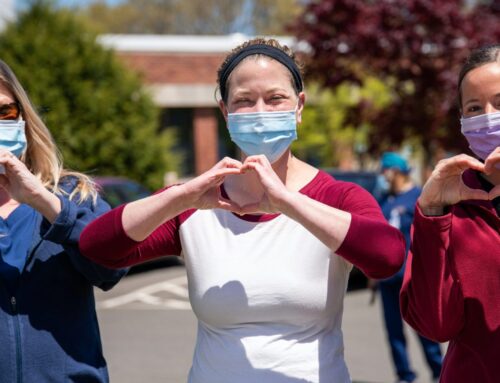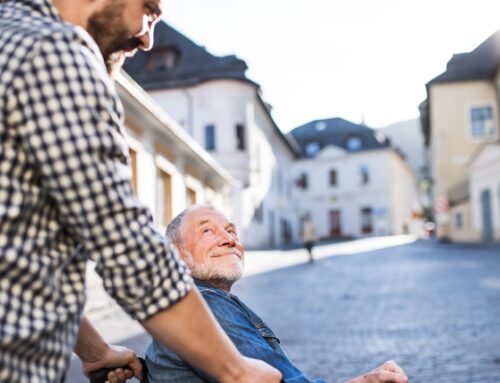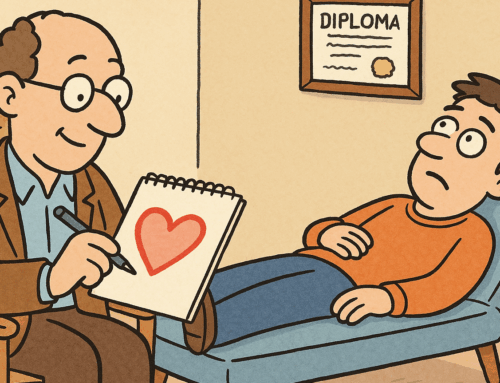Ask Your Doctor if Kindness is Right for You: Kindness and Physical Health
“Exercise and good nutrition, for all their power to keep us healthy, are not enough. The next revolution in health care must be to bring to our awareness the health potential of helping others. The present headlined health revolution will not be completed until people realize that no matter how much they concentrate on themselves, they cannot achieve optimum health. They have to relate to others.” -The Healing Power of Doing Good
By: M.T. Bennett
One Kind Act a Day is able to spread kindness thanks to the generosity and support of our parent organization, the Semnani Family Foundation. The Foundation is able to do incredible work to empower the disadvantaged, and we are lucky to have several amazing sister organizations supported by the Semnani Family Foundation. These organizations support the arts, civic involvement, healthcare, and more.
In 2025 one of our sister organizations, the Maliheh Free Clinic, celebrated their 20th anniversary! So far, they have provided free same-day medical care to over 260,000 patients. This has made me think a lot about the intersection between health and kindness and I want to share a series of articles about how kindness is good for our bodies, good for our minds, and the power of kind healthcare providers.
Kindness Prescription
The research on how kindness improves our health isn’t good…it is incredible. However, I’m willing to bet that you’ve never had a healthcare provider say, “Well you could stand to lose a few pounds, those moles need a biopsy soon, take 81 mg of Aspirin daily to prevent strokes, here is some propranolol for your performance anxiety, and…oh yeah, have you considered being kinder?”
Why don’t we use kindness as a healthcare intervention? Perhaps physicians feel limited in the efficacy of a few brief minutes with their patients to create lasting behavioral changes. Maybe because there is no medical code for “kindness prescription” to include on a patient’s chart. Or perhaps it is because much of medical training focuses on the treatment of pathology. I suspect the answer lies in several reasons that are beyond the scope of this article.
The fact of the matter is that kindness is good for the human organism. It makes us healthier. We should be encouraging kindness in our health. I would like to point out that the Maliheh Free Clinic is kind enough to have a large sign encouraging patients to do “One Kind Act a Day”. If you’re a medical provider, perhaps in your exam rooms next to the anatomical models and posters telling patients to about the benefits of Blujepa you could include information on the power of kindness in our health. Let’s explore a few of those benefits.
Kindness is Good for Your Heart
Kindness isn’t just heartwarming; it actually benefits your cardiovascular system in tangible ways. When we are kind we reduce our stress levels, bring down our blood pressure, and lessen strain on our blood vessels and heart itself. In a study by Northwestern University and Mount Sinai School of Medicine, researchers studied 10th grade students who volunteered to serve younger kids. They found that volunteers “who increased the most in empathy and altruistic behaviors, and who decreased the most in negative mood, also showed the greatest decreases in cardiovascular risk over time.”
Numerous studies show that spending money on others brings greater happiness than spending on ourselves. Surprisingly, it also benefits our hearts. One study took participants with chronic high blood pressure and gave them $40 to spend on themselves or on others. They did this on three separate occasions. At the end of the study they found that those who spent money on others had lower blood pressure than those who spent on themselves. They said it is “comparable to the effects of interventions such as hypertensive medication or exercise.”
In the 1970’s Dr. Friedman and Rosenman implemented an intervention with patients who had a history of heart attacks. They sought to lower stress levels by decreasing patient’s hostility and anger by asking patients to “put yourself in another person’s shoes” and foster behaviors that involved “consideration for and…love for others.” Patients who did this reduced their risk of repeat heart attacks by half.
I could go on and on, but you get the point. Kindness makes your heart feel better and makes it work better.
Kindness and Chronic Pain
As we age all of us develop aches and pains. Some of us are unlucky enough to develop debilitating chronic pain from injuries and more. It can get so severe that patients are willing to try just about anything to alleviate the constant pain. While kindness cannot fully erase pain, studies have shown that patients who exercise a focus on kindness, such as through loving-kindness meditation, report less pain.
Serving, kindness, and altruistic behaviors can benefit those with chronic pain. Some studies showed that altruistic behaviors could alleviate the experience of chronic and acute pain. It not only relieves your pain but can help alleviate the pain of others. One study had patients with chronic pain be peer-supporters to help others with similar conditions. Those who volunteered reported less pain AND those they served experienced less pain. This supports one of my favorite quotes on kindness, that, “kindness is the most effective way to improve your well-being and the well-being of another person at the same time.” -Pressman et al., 2015
Has pain ever gotten in the way of work? An old back injury acting up after long hours sitting at your desk? Knee pain when standing for extended periods? One study looked at the effect of volunteering and charitable giving and how it alleviated pain that interferes with one’s work. They found that people who donated money had less interference with their work from chronic pain. Those who donated AND volunteered saw even less impact in their profession from chronic pain. Isn’t that amazing? Think about it, if you’re lucky enough to have a place like the Maliheh Free Clinic where you live, you could donate money AND volunteer. If you did you would be supporting the health of others while also improving your own health! It is a win-win.
Kindness and Longevity
Do you want to live longer? It may be as easy as being a bit kinder.
As we age, we may wonder, “who is going to take care of us?” However, research seems to suggest that, if we want to live longer, we should be asking, “who are we going to take care of?” Researchers studied how giving vs receiving support would influence mortality in older adults. They found that those who gave support to family, friends, and their community had significantly reduced mortality. So, as we grow older and retire, we shouldn’t just relax at home and become isolated. If we want to live more years with our grandkids the answer is to focus on how we can help other people.
In their amazing book “Wonder Drug” Drs. Trzeciak and Mazzarelli explain a study of 300,000 married couples and how volunteering and service affect mortality. Trzeciak and Mazzarelli say, “spouses who volunteer to serve others do indeed have a lower mortality risk. But their non-volunteering spouses who sleep in the same bed, eat the same dinner, hang out with the same friends, do not get the same longevity benefit. This supports the idea that the decisive factor isn’t address, diet, or the drapes…It’s whether a person gives a little bit of themselves and winds up, perhaps unintentionally, getting more of what we all want: time.”
If you want another good read check out “The Biology of Kindness” by Harvard Epidemiologist Dr. Immaculata De Vivo and Biologist Danile Lumera. In this book they talk about the impact of kind behaviors on our biology, especially with DNA and aging. Whenever our bodies create new cells they copy our DNA. Due to the mechanism of DNA replication, every copy of a chromosome is a little bit shorter than the one before it. Thankfully our chromosomes have areas called telomeres which are essentially “buffer” areas that keep us from losing vital information. Over time though these telomeres become too short and this can lead to senescence and apoptosis of cells. It is thought that telomere shortening is linked to aging and mortality. The book and other studies show that those who focus on kindness in their actions and attitudes have longer telomeres and are more resistant to cellular aging.
Kindness and DNA Expression
Have you ever heard “fight or flight”? This refers to our body’s stress response to a stimulus which helps us to fight off an attack or flee from danger. This is a natural and important physiological mechanism. However, it is meant to be used for short term emergencies, not long periods of time.
Dr. Robert Sapolsky, my third favorite primatologist, wrote a book called “Why Zebras Don’t Get Ulcers”. People used to think that ulcers were caused by chronic stress (we now know they are usually from H. pylori bacteria and can be aggravated by things like stress or overuse of NSAID medications). The title of his book refers to this antiquated belief that stress causes ulcers, and he posits that “zebras don’t get ulcers” because they don’t have chronic stress like humans do. He says:
“This is the critical point of this book: if you are that zebra running for your life, or that lion sprinting for your meal, your body’s physiological response mechanisms are superbly adapted for dealing with such short-term physical emergencies. For the vast majority of beasts on this planet, stress is about a short-term crisis, after which it’s either over with or you’re over with. When we sit around and worry about stressful things, we turn on the same physiological responses—but they are potentially a disaster when provoked chronically. A large body of evidence suggests that stress-related disease emerges, predominantly, out of the fact that we so often activate a physiological system that has evolved for responding to acute physical emergencies, but we turn it on for months on end, worrying about mortgages, relationships, and promotions.”
Human beings have incredible minds that allow us to imagine and create wonderful things. They also let us ruminate and worry for weeks, months, even years. When we do that, we activate our “fight or flight” stress response for extended periods of time. This stress response causes long-term wear and tear on our bodies. It can even impact the expression of our DNA.
A short biology lesson. Our DNA is a long strand of instructions wrapped around proteins called histones. If a methyl group is on the DNA, it wraps tight around the histones and cannot be transcribed. If an acetyl group is on the DNA, it wraps loosely to the histones, leaving space for transcription factors to access the DNA and express those genes. Depending on a variety of factors, different parts of a strand of DNA will be methylated or acetylated which will turn on or turn off certain gene expression.
When I teach this concept, I usually ask students to consider that their DNA is a blueprint for our bodies like the blueprint for a house. Imagine that a construction crew is building a house, and the weather gets really hot, so the foreman decides, “Hey, this house only has one Air Conditioning unit, but it is hot so I think it will need two.” They consult the blueprint and add another AC unit. The heat wave continues so the foreman thinks, “Well, it would probably be good to add a third AC unit.” The weather is still hot, so they knock out some walls to improve air flow, then add more AC units. Soon, it becomes too much and you have a house with 20 AC units. The walls are unstable, the electric bill is too high, the house is really good at cooling itself off, but not much else.
Our bodies do a similar thing, expressing different parts of our “DNA blueprint” according to a need. Usually this is fine, until we get so stressed that we install 20 “AC Units”. The genes that our bodies express when stressed are called Conserved Transcriptional Response to Adversity (CTRA) genes. In response to adversity our bodies go into panic response mode and try to preserve themselves in the short run at the expense of the long run. Increased CTRA gene expression is often associated with increased inflammation, faster cellular aging, and a decreased immune response. Why would our body protect against a virus when it thinks a lion is about to eat us?
One study looked at CTRA gene expression between three groups; one performed kind acts for themselves, one performed kind acts for others, and a control. The found that “prosocial engagement — doing something kind for others rather than oneself — reduces CTRA gene expression.” So, maybe if you want to be healthier and take care of your body you don’t need to treat yourself to a spa day. Instead, visit a food pantry or mow your neighbor’s lawn. Performing kind acts for others doesn’t just change our attitudes, it changes who we are right down to the expression of our DNA. It literally changes the physical foundation of who we are as a person. That is incredible!
The Power of Kindness
The evidence for the power of kindness on our physical well-being is incredible. It also helps our mental health and having a kind healthcare provider is also a huge deal. So, if you want to live longer, have a healthier heart, and feel better, ask your doctor if kindness is right for you.
References
Arnstein, P., Vidal, M., Wells-Federman, C., Morgan, B., & Caudill, M. (2002). From chronic pain patient to peer: Benefits and risks of volunteering. Pain Management Nursing, 3(3), 94–103. https://doi.org/10.1053/jpmn.2002.126069
Brown, S. L., Nesse, R. M., Vinokur, A. D., & Smith, D. M. (2003). Providing Social Support May Be More Beneficial Than Receiving It. Psychological Science, 14(4), 320–327. https://doi.org/10.1111/1467-9280.14461
Carson, J. W., Keefe, F. J., Lynch, T. R., Carson, K. M., Goli, V., Fras, A. M., & Thorp, S. R. (2005). Loving-Kindness Meditation for Chronic Low Back Pain. Journal of Holistic Nursing, 23(3), 287–304. https://doi.org/10.1177/0898010105277651
Cole, S. W. (2019). The Conserved Transcriptional Response to Adversity. Current Opinion in Behavioral Sciences, 28, 31–37. https://doi.org/10.1016/j.cobeha.2019.01.008
Dunn, E. W., Aknin, L. B., & Norton, M. I. (2008). Spending Money on Others Promotes Happiness. Science, 319(5870), 1687–1688. https://doi.org/10.1126/science.1150952
Fritz, M. M., Walsh, L. C., Cole, S. W., Epel, E., & Lyubomirsky, S. (2021). Kindness and cellular aging: A pre-registered experiment testing the effects of prosocial behavior on telomere length and well-being. Brain, Behavior, & Immunity – Health, 11, 100187. https://doi.org/10.1016/j.bbih.2020.100187
Immaculata De Vivo, & Lumera, D. (2024). The Biology of Kindness. MIT Press.
Le Nguyen, K. D., Lin, J., Algoe, S. B., Brantley, M. M., Kim, S. L., Brantley, J., Salzberg, S., & Fredrickson, B. L. (2019). Corrigendum to “Loving-kindness meditation slows biological aging in novices: Evidence from a 12-week randomized controlled trial” [Psychoneuroendocrinology 108 (2019) (October) 20-27]. Psychoneuroendocrinology, 109, 104440. https://doi.org/10.1016/j.psyneuen.2019.104440
Luks, A., & Payne, P. (2001). The healing power of doing good : the health and spiritual benefits of helping others. Iuniverse.com.
Macchia, L., Farmer, J., & Kubzansky, L. D. (2023). Prosocial behaviour helps to ease physical pain: Longitudinal evidence from Britain. Journal of Psychosomatic Research, 111325. https://doi.org/10.1016/j.jpsychores.2023.111325
Meyer Friedman, & Rosenman, R. H. (1974). Type A behavior and your heart. Ballantine Books.
O’Reilly, D., Rosato, M., Moriarty, J., & Leavey, G. (2017). Volunteering and mortality risk: a partner-controlled quasi-experimental design. International Journal of Epidemiology, 46(4), 1295–1302. https://doi.org/10.1093/ije/dyx037
Regan, A., Fritz, M. M., Walsh, L. C., Lyubomirsky, S., & Cole, S. W. (2022). The genomic impact of kindness to self vs. others: A randomized controlled trial. Brain, Behavior, and Immunity, 106, 40–48. https://doi.org/10.1016/j.bbi.2022.07.159
Sapolsky, R. (2004). Why zebras don’t get ulcers (3rd ed.). Holt. (Original work published 1994)
Schreier, H. M. C., Schonert-Reichl, K. A., & Chen, E. (2013). Effect of Volunteering on Risk Factors for Cardiovascular Disease in Adolescents. JAMA Pediatrics, 167(4), 327. https://doi.org/10.1001/jamapediatrics.2013.1100
Trzeciak, S., & Mazzarelli, A. (2022). Wonder Drug. St. Martin’s Essentials.
Wang, Y., Ge, J., Zhang, H., Wang, H., & Xie, X. (2019). Altruistic behaviors relieve physical pain. Proceedings of the National Academy of Sciences, 117(2), 950–958. https://doi.org/10.1073/pnas.1911861117
Whillans, A. V., Dunn, E. W., Sandstrom, G. M., Dickerson, S. S., & Madden, K. M. (2016). Is spending money on others good for your heart? Health Psychology, 35(6), 574–583. https://doi.org/10.1037/hea0000332







